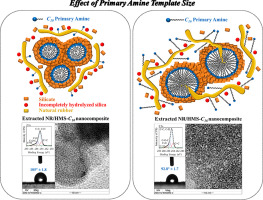Microporous and Mesoporous Materials ( IF 4.8 ) Pub Date : 2018-09-06 , DOI: 10.1016/j.micromeso.2018.09.004 Sakdinun Nuntang , Satit Yousatit , Toshiyuki Yokoi , Chawalit Ngamcharussrivichai

|
Polymer/silica nanocomposites with diverse mesoporosity and hydrophobic properties have actual and potential applications in the area of catalysis, adsorption and drug delivery. The present work reports a simple but efficient approach to tune the mesostructure and hydrophobicity of natural rubber (NR)/hexagonal mesoporous silica (HMS) nanocomposites synthesized via the in situ sol-gel technique in the presence of different primary amines (CnH2n+1NH2, n = 8, 10, 12, 14 and 16) as structural templating agents. The change in the mesostructure ordering and textural properties of the NR/HMS nanocomposites with different template sizes was similar to that for the pure silica HMS series. Powder X-ray diffraction and transmission electron microscopy analyses revealed an expansion of the hexagonal unit cell and channel wall thickness of the nanocomposites due to the incorporated rubber molecules. Using amine templates with longer alkyl chains provided NR/HMS materials with a higher NR content at 13.7–15.6 wt% but decreased the rubber phase dispersion and hydrophobic properties. X-ray photoelectron spectroscopy indicated that the amount of NR exposed at the composite's surface was 7.99–9.48 wt%, while the remaining NR was incorporated into the mesostructured silicate framework and/or entrapped in the mesopores. The hydrophobic interaction between the NR molecules and the alkyl chains of primary amine template was probably a crucial factor that determined the rubber phase dispersion, and so the hydrophobic character, in the NR/HMS nanocomposites.
中文翻译:

天然橡胶/六角形介孔二氧化硅纳米复合材料的可调介孔性和疏水性
具有不同介孔性和疏水性的聚合物/二氧化硅纳米复合材料在催化,吸附和药物递送领域具有实际和潜在的应用。本工作报告了一种简单而有效的方法,用于调节在不同伯胺(C n H 2)存在下通过原位溶胶-凝胶技术合成的天然橡胶(NR)/六方介孔二氧化硅(HMS)纳米复合材料的介孔结构和疏水性n +1 NH 2,n = 8、10、12、14和16)作为结构模板剂。具有不同模板尺寸的NR / HMS纳米复合材料的介观结构有序性和结构特性的变化与纯二氧化硅HMS系列的相似。粉末X射线衍射和透射电子显微镜分析显示由于掺入的橡胶分子,六角形晶胞的膨胀和纳米复合材料的通道壁厚。使用具有更长烷基链的胺模板可为NR / HMS材料提供更高的NR含量,含量为13.7-15.6 wt%,但降低了橡胶相的分散性和疏水性。X射线光电子能谱表明,复合材料表面的NR暴露量为7.99–9.48 wt%,而其余的NR则被掺入到中型结构的硅酸盐骨架中和/或被包埋在中孔中。NR分子与伯胺模板的烷基链之间的疏水相互作用可能是决定橡胶相分散性的关键因素,因此决定了NR / HMS纳米复合材料的疏水性。










































 京公网安备 11010802027423号
京公网安备 11010802027423号